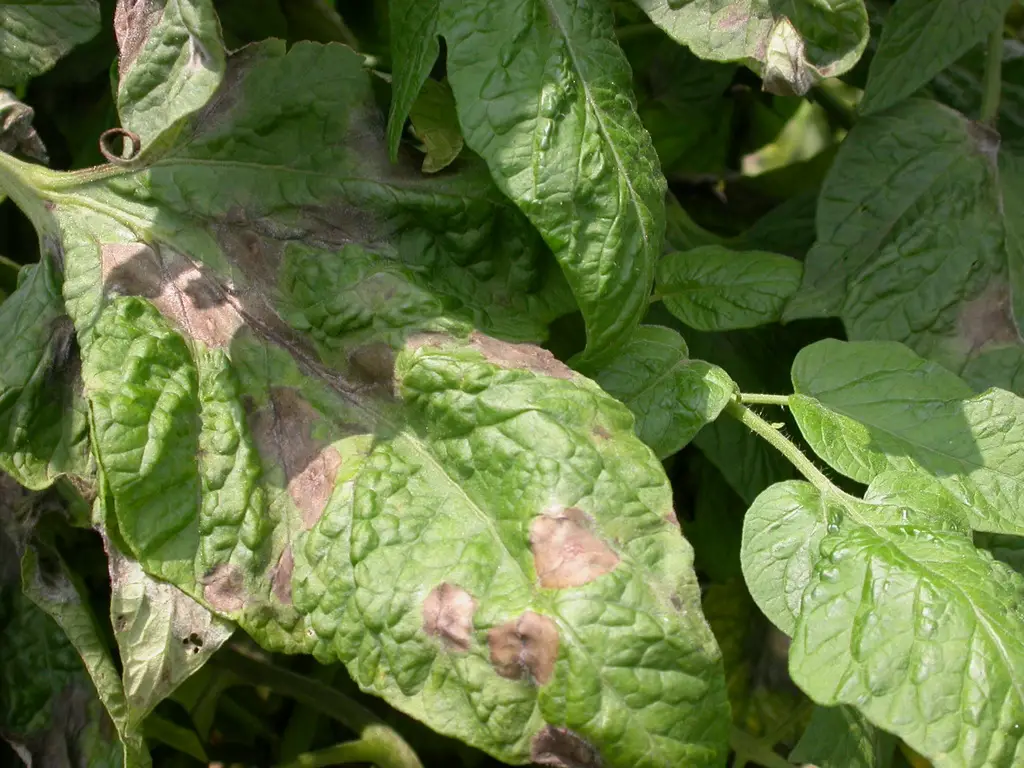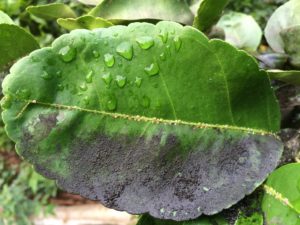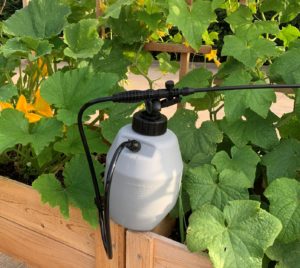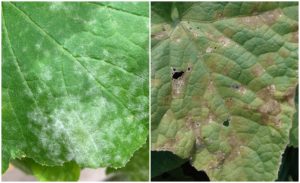The three types of blight that most often affect tomatoes are early blight, late blight, and Septoria leaf spot. In this article, you will learn how to identify, treat, and prevent late blight. Although the focus of this article is on tomatoes, the information can be applied to other members of the nightshade family, such as potatoes, peppers, and eggplant.
What is Late Blight
Late blight is a fungal disease caused by the water mold Phytophthora infestans. It primarily targets tomatoes and potatoes and, to a lesser extent, peppers and eggplant. It is the same pathogen that was responsible for the Irish potato famine that occurred in the 1840s.
Ideal conditions for infection and spread of this pathogen occur when there is high humidity, 90% or more, and temperatures are between 70°F and 80°F (21°C and 26°C). While these are ideal conditions, the pathogen can produce spores in less-than-optimal conditions.
Phytophthora infestans is called late blight because it occurs later in the growing season, thus distinguishing it from early blight. Regardless of the seasonal designations, late blight can occur anytime during the growing season when the weather is wet and cool.
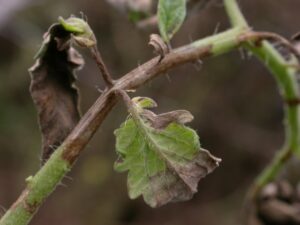
How to Identify Late Blight
The fungus attacks the plant through leaf stomata, so it is no surprise that symptoms first appear on the lower leaves. Tan to light brown, irregular shaped spots or lesions will develop, often near the tips of the leaves. The spots will turn brown to dark olive green to black with a light green border on the underside. The lesions may have a lighter colored halo or single ring encircling them.
As the lesions grow, a white to gray mold will appear on the underside of the leaves. As the infection spreads, the lesions on leaves and stems will turn brown and shrivel. In advanced stages, other portions of the plant may have mold as well. Progression of disease occurs rather quickly, and complete defoliation can occur in as little as one to two weeks.
Infected fruit will develop dark, shiny lesions, usually on the top or sides of the tomato, as opposed to blossom end rot, where the lesions form on the bottom of the fruit. The lesions have been described by some as looking “greasy.” The spots are circular and will eventually coalesce to cover large portions of the fruit. While the lesions are firm, a secondary bacterial infection may occur that will cause the spots to become soft.
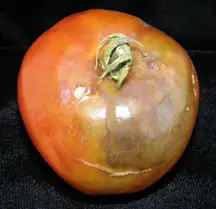
How to Distinguish Late Blight from Early Blight
The best way to determine if a plant has early or late blight is to look for lesions with concentric circles since this is a tell-tale sign that occurs only in early blight.
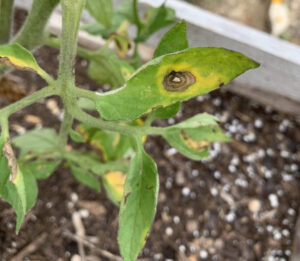
How to Test for Late Blight
If you suspect your plant has this pathogen, take a portion of the infected tissue (leaf, stem, or fruit), place it in a sealed bag with a damp paper towel. Check the tissue after twelve hours. If it has grown mold, then you have late blight. Remove the plant from the garden, place it in a trash bag, and throw it away. Do not compost it because most compost post piles do not maintain high enough temperatures to kill the pathogen.
Disease Transmission
Spores are transmitted by water, both by irrigation and rain, as well as by the wind, which can carry them five miles or more. Spores can also travel between tomato and potato crops and other members of the nightshade family. In addition, spores can spread via contaminated tools and infected plants brought into the garden.
Can You Save Seeds?
Yes, you can safely save seeds from infected fruit since the pathogen is not seed borne. Seed potatoes, on the other hand, can be infested, so it is important to purchase only certified seed potatoes.
Does Late Blight Overwinter?
Late blight does not overwinter in the soil as it must have living tissue to survive. In warmer climates where plants may not succumb to the cold, spores may live on tomato plants (and other nightshades) and plant debris.
This article contains affiliate links. If you make a purchase using one of these links, I will receive a very small commission at no additional cost to you, and it will help me maintain this website. Rest assured, I only recommend products I actually like!
How to Treat, Manage, and Prevent
There is no cure for late blight. You may, however, be able to prevent or slow down the progression of the disease by applying a fungicide before any signs of the pathogen appear. Once symptoms occur, recovery is not likely.
Although limited in its effectiveness against late blight, one possible preventative measure is to apply a DIY baking soda spray used by many to combat powdery mildew. Baking soda disrupts the balance of ions in fungal cells, which can result in their collapse. The alkaline residue left behind by the sodium bicarbonate, as it is also called, can help to kill spores.
Dissolve 1 teaspoon of baking soda and a drop or two of a chemical-free soap, like Dr. Bonner’s, in 1 quart of water. For broader applications, add one heaping tablespoon of baking soda and several drops of a chemical-free soap to a one-gallon sprayer and fill with water. Be sure to perform a test spray, waiting 24-48 hours to see if there is any leaf tissue damage. If there is no damage, you can spray the entire plant. If damage occurs, dilute the spray and test again. Spray every week or so. Reapply after it rains.
Some advocate for treating late blight with a copper-based fungicide or a systemic foliar spray that contains mono- and di-potassium salts of Phosphorous Acid. Others recommend using a broad-spectrum bio-fungicide containing Bacillus subtilis or Bacillus amyloliquefaciens strain D747. Regardless of which of these methods you use, they are limited in their ability to delay disease progression, and they must be applied before any sign of infection occurs.
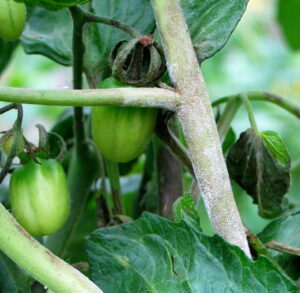
Practical Management and Prevention Tips
The following tips can help in both disease management and prevention:
- Plant late blight resistant cultivars.
- Inspect any plants brought into the garden for signs of disease.
- When planting, space plants to ensure adequate airflow between them. This will help the plants dry faster after it rains.
- Prune plants to provide adequate airflow and to remove diseased leaves. Leaves should have as much exposure to sun as possible to keep them dry.
- Refrain from overhead watering as wet leaves create a breeding ground. Use a drip irrigation system if possible.
- Remove any diseased plants, place them in a trash bag and throw them away. Do not compost any part of a plant as most home compost piles do not maintain high enough temperatures to kill the pathogen.
- Remove any volunteer tomato and potato plants, as well as other members of the nightshade family, including weeds such as Carolina horse nettle and black nightshade, as these can harbor spores.
- Clean any tools, trellises, stakes, etc. that have come into contact with the infected plant using isopropyl alcohol or a bleach solution of one part bleach to nine parts water.
- Daily inspect the garden for signs of disease and act immediately if infection is found.
While late blight in tomatoes and potatoes is a devasting plant disease, there are measures you can take to slow down disease progression and even prevent the fungus from taking hold in the first place.
Thank you for reading this article! If you found it helpful, please consider sharing it with others via email and social media!
